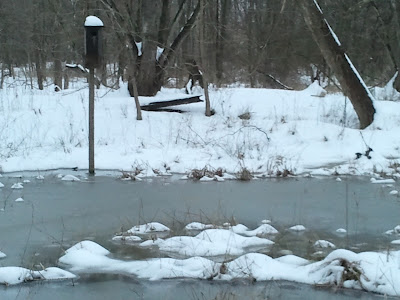 |
| A nesting box built by Alicia Johnston and Gina Armstrong in 2007, and erected by Grace Young and Katie Lloyd (and their helpful parents). |
 |
| With the river in the background. |
Observing and reporting the phenology along the South Branch of the Potomac in Hampshire County, West Virginia.
 |
| A nesting box built by Alicia Johnston and Gina Armstrong in 2007, and erected by Grace Young and Katie Lloyd (and their helpful parents). |
 |
| With the river in the background. |
 |
| Looking upstream toward Levels, WV. |
 |
| Snow highlights the unusual cliff formations across the river. |
| ||||||||||||||||||||

 On a foggy morning my brother Brian and my nephew Luke transport the fruits of the Osage Orange (Maclura pomifera) to places along the flood plain where the seeds will be planted to develop a natural hedgerow/fence. We have dozens of these trees on our farm, and soon we'll begin seeing the deer and squirrels relying on them for food.
On a foggy morning my brother Brian and my nephew Luke transport the fruits of the Osage Orange (Maclura pomifera) to places along the flood plain where the seeds will be planted to develop a natural hedgerow/fence. We have dozens of these trees on our farm, and soon we'll begin seeing the deer and squirrels relying on them for food.
 Milkweed (Asclepias syriaca) along the South branch of the Potomac. Last year we began culturing milkweed for schools with butterfly programs.
Milkweed (Asclepias syriaca) along the South branch of the Potomac. Last year we began culturing milkweed for schools with butterfly programs. 18:53Training Young Trees39 views | 1 month ago
18:53Training Young Trees39 views | 1 month ago 0:51Chapter 1: Introduction6 views | 1 month ago
0:51Chapter 1: Introduction6 views | 1 month ago 1:20Chapter 2: Why Train Young Trees?1 view | 1 month ago
1:20Chapter 2: Why Train Young Trees?1 view | 1 month ago 0:49Chapter 3: What Does A Well-Trained Tree Look Like?2 views | 1 month ago
0:49Chapter 3: What Does A Well-Trained Tree Look Like?2 views | 1 month ago 0:55Chapter 4: What's the Investment?1 view | 1 month ago
0:55Chapter 4: What's the Investment?1 view | 1 month ago 0:49Chapter 5: When Do I Prune and How Much?1 view | 1 month ago
0:49Chapter 5: When Do I Prune and How Much?1 view | 1 month ago 0:52Chapter 6: The 5 Steps to Training Young Trees5 views | 1 month ago
0:52Chapter 6: The 5 Steps to Training Young Trees5 views | 1 month ago 0:48Chapter 7: Step 12 views | 1 month ago
0:48Chapter 7: Step 12 views | 1 month ago 1:04Chapter 8: Step 23 views | 1 month ago
1:04Chapter 8: Step 23 views | 1 month ago 1:14Chapter 9: Step 33 views | 1 month ago
1:14Chapter 9: Step 33 views | 1 month ago 1:18Chapter 10: Step 41 view | 1 month ago
1:18Chapter 10: Step 41 view | 1 month ago 0:58Chapter 11: Step 54 views | 1 month ago
0:58Chapter 11: Step 54 views | 1 month ago 4:41Chapter 12: The 5 Steps in Action2 views | 1 month ago
4:41Chapter 12: The 5 Steps in Action2 views | 1 month ago 1:07Chapter 13: Tree Response to Training Over Time2 views | 1 month ago
1:07Chapter 13: Tree Response to Training Over Time2 views | 1 month ago 2:14Chapter 14: Summary and Review2 views | 1 month ago
2:14Chapter 14: Summary and Review2 views | 1 month ago